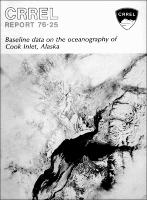Please use this identifier to cite or link to this item:
https://hdl.handle.net/11681/9541Full metadata record
| DC Field | Value | Language |
|---|---|---|
| dc.contributor | United States. National Aeronautics and Space Administration | - |
| dc.contributor.author | Gatto, Lawrence W. | - |
| dc.date.accessioned | 2016-06-20T13:42:22Z | - |
| dc.date.available | 2016-06-20T13:42:22Z | - |
| dc.date.issued | 1976-07 | - |
| dc.identifier.uri | http://hdl.handle.net/11681/9541 | - |
| dc.description | CRREL Report | - |
| dc.description | Abstract: The primary objective of this investigation was to compile baseline information pertaining to the ocean circulation, especially the extent and patterns of tidal currents and tidal flushing, in Cook Inlet, Alaska, utilizing aircraft and satellite imagery with corroborative ground truth data. LANDSAT-1 and NOAA-2 and -3 imagery provided repetitive, synoptic views of surface currents, water mass migration and sediment distribution during different seasons and tides. Color, color infrared and thermal infrared imagery acquired on 22 July 1972 with the NASA NP-3A aircraft were used to analyze currents, mixing patterns and sediment dispersion in selected areas. Temperature (°C), salinity (‰) and suspended sediment concentration (mg/l) data and hand-held photography were utilized as ground truth information in the interpretation of the aircraft and satellite imagery. Coriolis effect, semidiurnal tides and the Alaska current govern the estuary circulation. Clear, oceanic water enters the inlet on the southeast during flood tide, progresses northward along the east shore with minor lateral mixing, and remainsa distinct water mass to the latitude of Kasilof-Ninilchik. South of the forelands, mixing with turbid inlet water becomes extensive. Turbid water moves south primarily along the north shore during ebb tide and a shear zone between the two water masses forms in mid-inlet south of Kalgin Island. Currents adjacent to and north of the forelands are complicated by tidal action, coastal configuration and bottom effects. Turbulence is greatest throughout the water column along the south shore and stratification is more pronounced in Kamishak and Kachemak Bays, especially when fresh water runoff is high. Most of the sediment discharged into the inlet is deposited on the extensive tidal flats or removed by tidal currents along the west side during ebb flow. Bottom scouring is evident along the east shore south of Pt. Possession. Regional relationships between river hydrology, sediment transport, circulation and coastal processes were analyzed utilizing aircraft, LANDSAT-1 and NOAA-2 and -3 imagery and corroborative ground truth data. The use of satellite and aircraft imagery provides a means of acquiring synoptic information for analyzing the dynamic processes of Cook Inlet in a fashion not previously possible. | - |
| dc.publisher | Cold Regions Research and Engineering Laboratory (U.S.) | - |
| dc.publisher | Engineer Research and Development Center (U.S.) | - |
| dc.relation | http://acwc.sdp.sirsi.net/client/en_US/search/asset/1011471 | - |
| dc.relation.ispartofseries | CRREL report ; 76-25. | - |
| dc.rights | Approved for public release; distribution is unlimited. | - |
| dc.source | This Digital Resource was created from scans of the Print Resource | - |
| dc.subject | Anchorage (Alaska) | - |
| dc.subject | Bathymetry | - |
| dc.subject | Cook Inlet, Alaska | - |
| dc.subject | Data acquisition | - |
| dc.subject | Infrared photography | - |
| dc.subject | Oceanography | - |
| dc.subject | Ocean currents | - |
| dc.subject | Tidal currents | - |
| dc.subject | Water chemistry | - |
| dc.subject | Satellites (artificial) | - |
| dc.title | Baseline data on the oceanography of Cook Inlet, Alaska | - |
| dc.type | Report | en_US |
| Appears in Collections: | CRREL Report | |
Files in This Item:
| File | Description | Size | Format | |
|---|---|---|---|---|
| CR-76-25.pdf | 21.73 MB | Adobe PDF |  View/Open |